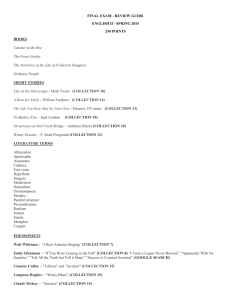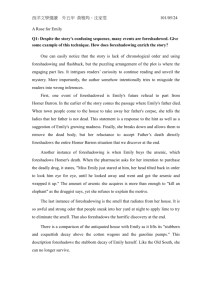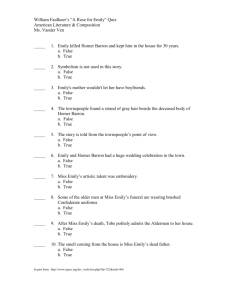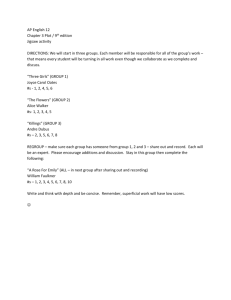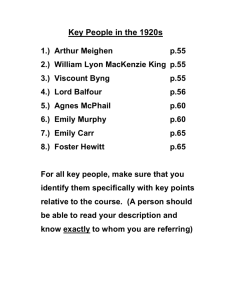The Grapes of Wrath
advertisement
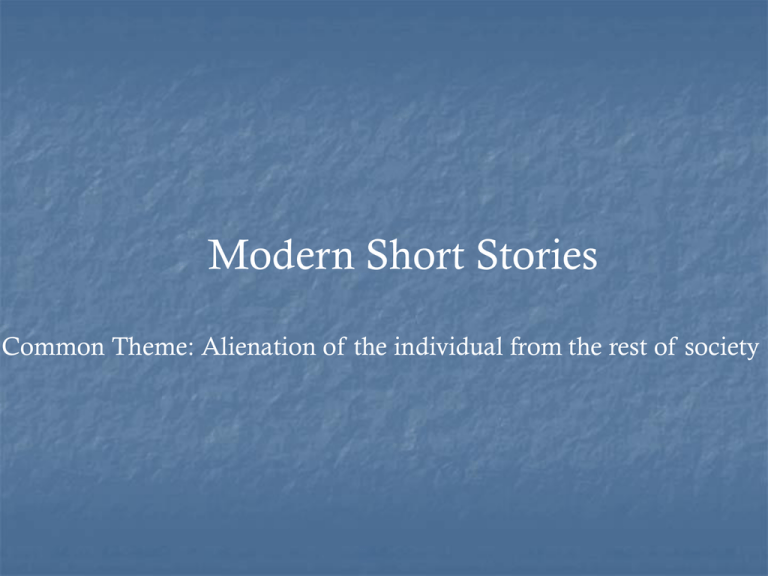
Modern Short Stories Common Theme: Alienation of the individual from the rest of society Ernest Hemingway Used his own experiences as an ambulance driver in WWI and later as a journalist during WWII Felt war was the ultimate setting to observe human nature and “grace under pressure” Explored how soldiers adapted to civilian life after service Sense of alienation from civilians—can’t express what they experienced during the war and experiences can’t be understood by those who did not participate Restlessness and dissatisfaction with life at home—life after the war will never be as exciting or dangerous Ernest Hemingway Style--Plain style (20th century version) Hemingway wanted to write characters who spoke like regular people Rebelled against stream of consciousness Includes Syntax: sentence structure is simple, straightforward sentences—no complicated clauses Diction: word choice Slang Short, simple dialogue Close attention to detail Tone: Author’s attitude toward subject Non judgmental; journalistic—observes and reports William Faulkner All his stories focused on the land and the people of northern Mississippi, won the Nobel Prize for Lit. in 1949 Southern Gothic Tales—includes elements of Disturbed or mentally unbalanced characters Strange or terrifying events Gloomy run-down settings Style—made Faulkner difficult to read and cost him a bigger audience Novels and stories were in stream of consciousness Attempts to capture the moment by moment flow of thought in a character’s mind Both tragic and comic overtones Flashbacks and Events told out of chronological order—Reader must be able to piece together seemingly random events William Faulkner Themes Mainly focused on the American South as a microcosm for following universal themes: The passage of time—some adapt and others are left behind Passions of the heart—are sometimes the most dangerous and ugliest of desires William Faulkner Literary Devices 1st person narrator—represents the voice of the ENTIRE town of Jefferson Preserves the manners of Southern life at the turn of the 20th century, including racist sentiments of whites toward African Americans Narrator will not tell the events of Miss Emily’s life in chronological order “A Rose for Emily” Characterization Physical descriptions In her 60s—”a small, fat woman in black”, “she looked bloated”, “her eyes, lost in the fatty ridges of her face, looked like two small pieces of call pressed into a lump of dough”—this is while she lives (secretly) with Homer’s decaying body upstairs In her 20’s, when her dad was still alive—”a slender figure in white” At 30, after her dad dies—”her hair was cut short, making her look like a girl again When dating Homer (and buying the poison)—”a slight woman, thinner than usual, with cold, haughty black eyes in a face the flesh of with was strained across the temples”—she is desperate and losing it as she has realized Homer won’t marry her In her 40s and 50s—”she had grown fat”, “her hair was turning gray” What does Miss Emily look like over time? “A Rose for Emily” Characterization—Actions and Behavior When her dad dies—she denies the death for 3 days and keeps the body in the house with her. She’s a shut in for a while but re-emerges looking like a girl again Dating Homer—”She carried her head high enough”, as if having a man gave her the confidence she needed to restore her aristocratic attitude When Homer returns—she is not seen for some time, only at the windows in the house Her final years—she totally isolates herself from the town, “refused to let them fasten metal numbers above her door” “A Rose for Emily” Foreshadowing Emily’s response to her father’s death foreshadows…. The bad smell around Emily’s house foreshadows…. That she might keep Homer’s body later The discovery of Homer’s body in the bedroom The purchase of the poison foreshadows… The murder of Homer “A Rose for Emily” Sequencing the Events in Chronological Order 1. 2. 3. 4. 5. 6. 7. 8. 9. 10. 11. Emily’s father won’t allow her to date Emily’s father dies Homer Barron arrives in town Emily asks the druggist for poison Emily’s cousins visit; she purchases toilet set, suit, nightshirt Homer Barron leaves/disappears from town. The men secretly apply lime around her house to combat the smell Emily gives painting lessons to town’s children The new aldermen visit Emily about taxes Miss Emily dies Homer’s body is discovered Katherine Anne Porter Regarded as one of the greatest short story writers of the 20th century Personal struggle to define herself as an individual, a Southern Woman, and a writer shaped all of her stories. Started her only novel, Ship of Fools, in 1941—published in 1962: received the National Book Award and the Pulitzer Prize “The Jilting of Granny Weatherall” Style: Stream of Consciousness Narrative follows the thoughts of an 80 year old woman on her death bed Free association of ideas, drifting in and out of consciousness Both painful and pleasant memories Memory of being jilted by George is most painful of all; “That was Hell. She knew Hell when she saw it”. “The Jilting of Granny Weatherall” Discuss with your table groups and respond to the following 1. 2. 3. 4. 5. 6. What was the pinnacle of the American Dream for a young woman at the turn of the 20th century? Social Context of Story—Why was it so horrible to be “jilted” (left at the altar)? As a result of her eventual marriage and the early death of her husband, how did Granny challenge traditional female roles? Give three examples How is Granny Weatherall alienated from the world around her? What is the symbolism behind the main character’s name? Who “jilts” Granny a second time during this story? Who’s betrayal can she never forgive? John Steinbeck Grew up in Salinas Valley in California Influenced by the suffering and exploitation of migrant farm workers Led him to write his two most famous novels—Of Mice and Men and The Grapes of Wrath Witnessed horrors and aftermath of WWII as a news correspondent 6th American writer to win the Nobel Prize for Literature

